3. The Humanities and Childhood: Americans’ Experiences and Attitudes
A growing body of research demonstrates a link between childhood experiences with the humanities and academic success. One of the most robust findings in educational research is the positive relationship between early exposure to reading, a core humanities competency, and later academic achievement.15 Other research across a variety of domains—from linguistics to cognitive science—suggests that acquisition of a second language is more likely to be successful in childhood, and a study published in 2017 found that children in dual-language immersion programs (in which half of instruction is in English and half in another language) demonstrated greater English reading achievement.16
In view of the significance of exposure to the humanities for young people, a substantial portion of the Survey of the Humanities in American Life was dedicated to the humanities and childhood. The study’s findings enhance understanding of the childhood humanities experience in three key ways. First, they reveal the climate of opinion in which humanities education occurs, providing insight as to whether, when, and by whom Americans believe humanities subjects should be taught. The survey also yielded findings about the relationship between recalled childhood exposure17 and adult engagement with and attitudes toward the humanities. An analysis of data from the National Endowment for the Arts’ Survey of Public Participation in the Arts found that childhood engagement with the arts was associated with higher levels of adult participation, and the present survey suggests a similar association exists for the humanities.18 Finally, the survey reveals how Americans feel about their own humanities education. It sheds light on whether they now wish they had taken more courses in humanities subjects while they were students and how they feel about those subjects relative to others (such as science).
Childhood Exposure to the Humanities
To explore early childhood exposure, the survey asked respondents whether they remembered their parents engaging in a variety of humanities activities. For every activity in the survey, except discussing art, a majority of Americans recalled seeing their parents engage at least sometimes. Reading, however, was the only humanities activity that a majority (53%) recalled seeing their parents engage in often or very often (Figure 3A).
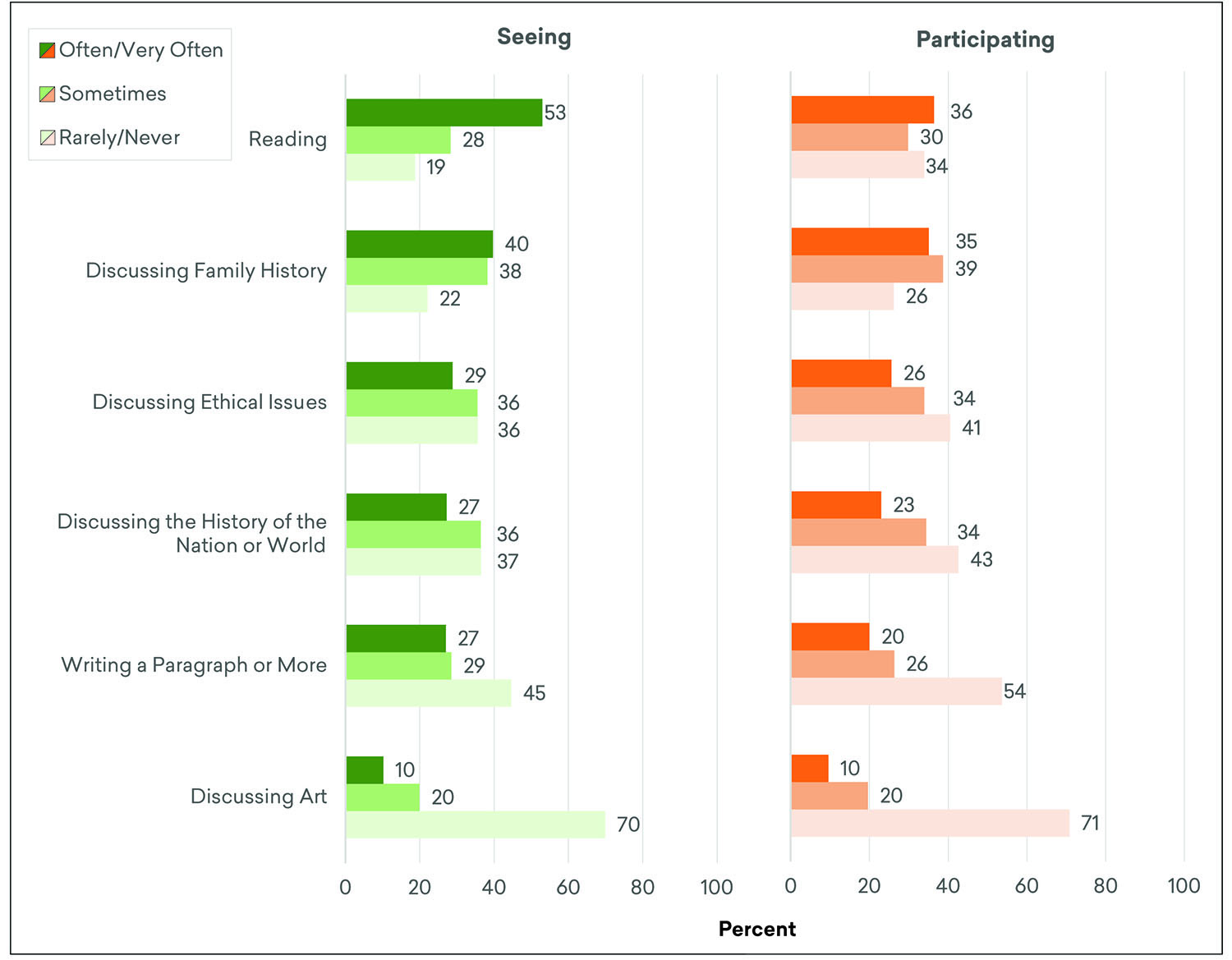
* Frequency shares for a given activity may sum to 99% or 101% due to rounding.
Source: Survey of the Humanities in American Life, 2019.
A substantial share of Americans also recalled their parents discussing family history with some frequency (40%). The least common type of childhood exposure was to parental discussions of art, as only 10% of Americans remembered this being a regular feature of their home lives during childhood.
The survey also asked people whether they had participated with their parents in the same activities and found that Americans were much less likely to have participated frequently in reading with their parents than to have seen their parents engage that regularly. While over half of Americans recalled seeing parents read often or very often, only 36% recalled participating in reading activities with them that frequently, and one-third of Americans never or only rarely read with their parents (less than 20% saw their parents read that infrequently). However, the share indicating that they “sometimes” participated with their parents in reading was virtually identical to the share who recalled seeing their parents read that frequently.19
Black Americans were more likely than those identifying as White or Hispanic to recall exposure to the humanities as children, a difference due largely to Black Americans’ greater tendency to recall participating with their parents in humanities activities (Figure 3B). Taking writing a paragraph or more as an example, when one moves from seeing to participating, the share for Whites shrinks by half. In the case of Black Americans, the share decreases by only one percentage point.
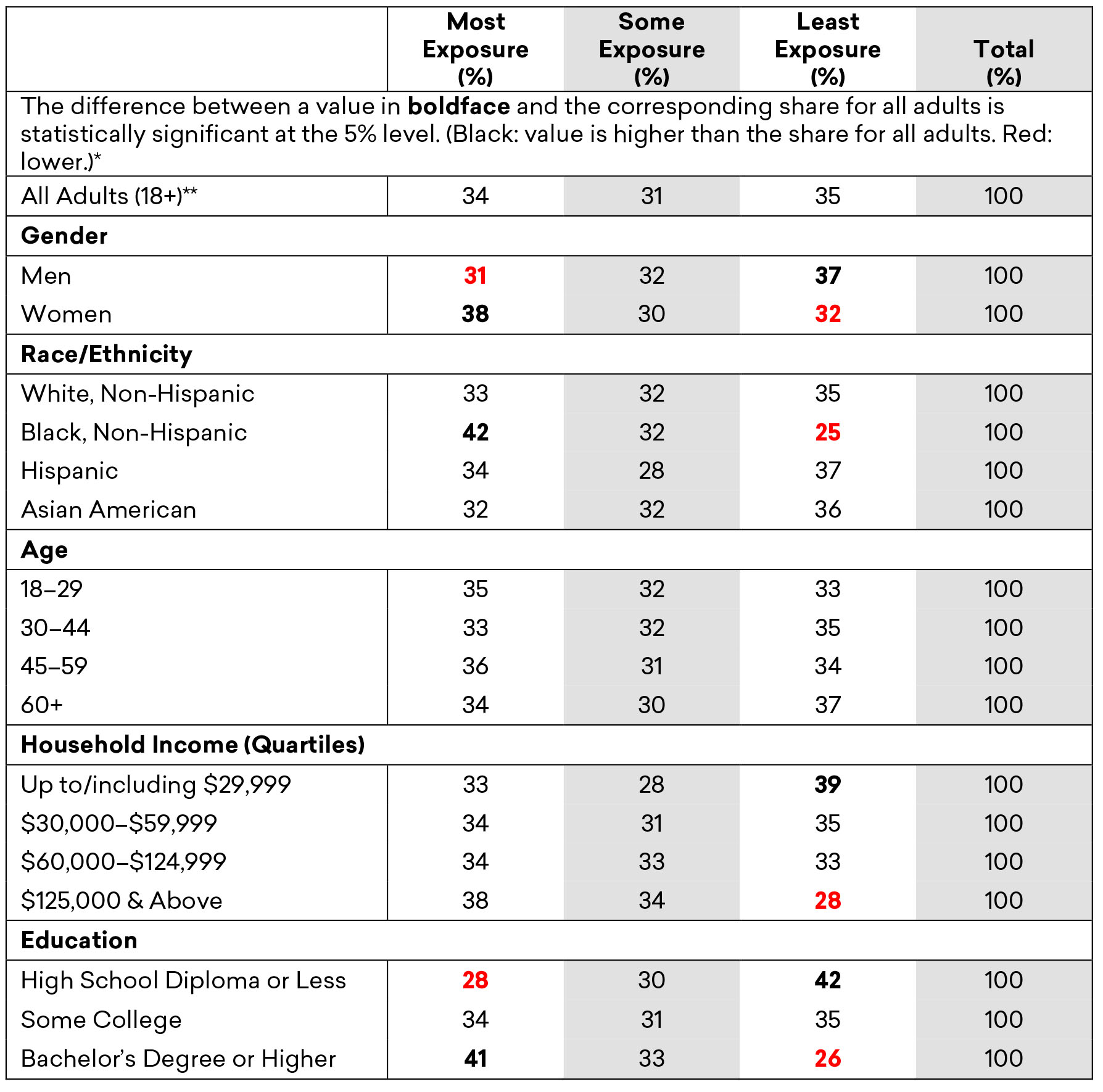
* Not every observed difference between demographic groups (e.g., between the youngest adults and those age 60+, or between Asian and White Americans) is statistically significant at the 5% level. The report narrative discusses notable differences that were found to be statistically significant. The “most”/“some”/“least” shares for a given demographic group may sum to 99% or 101% due to rounding.
** The childhood exposure segments (like those for adult engagement and perception) are relative, meaning that respondents have been compared to one another rather than to a fixed standard. Each survey respondent was assigned a score based on the number of activities they observed or participated in and the frequency of that exposure. Respondents falling in the top third (approximately) of the weighted distribution of the scores were assigned to the “most” exposure category, those with scores in the middle third to the “some” category, and those falling in the bottom third to “least.”
Source: Survey of the Humanities in American Life, 2019.
Gender was also a dimension of variation, with women somewhat more likely than men to recall exposure to the humanities as children. Childhood exposure to the humanities also differed with income. Only 28% of the most affluent Americans were among the least exposed, whereas 39% of the least affluent were in this category.
Childhood exposure to the humanities was positively associated with subsequent educational attainment. Forty-one percent of college-educated Americans were among the most exposed, as compared to 28% of Americans with a high school education or less. Because this analysis simply reveals a correlation between these two variables, the finding should not be understood to mean that greater humanities exposure in childhood led to higher educational attainment. The analysis was not designed to establish causal relationships.
Similarly, the analysis did not attempt to establish a causal linkage between reported childhood exposure and subsequent attitudes about and engagement with the field, but it did find a correlation. Americans who had more exposure to the humanities in their childhood homes were likelier to have positive views of the humanities (Figure 3C). Only 26% of Americans with the least exposure to the humanities in their childhood homes expressed a high level of enthusiasm for the humanities (using the scale described in Chapter 2), compared to 46% of those with the most childhood exposure.
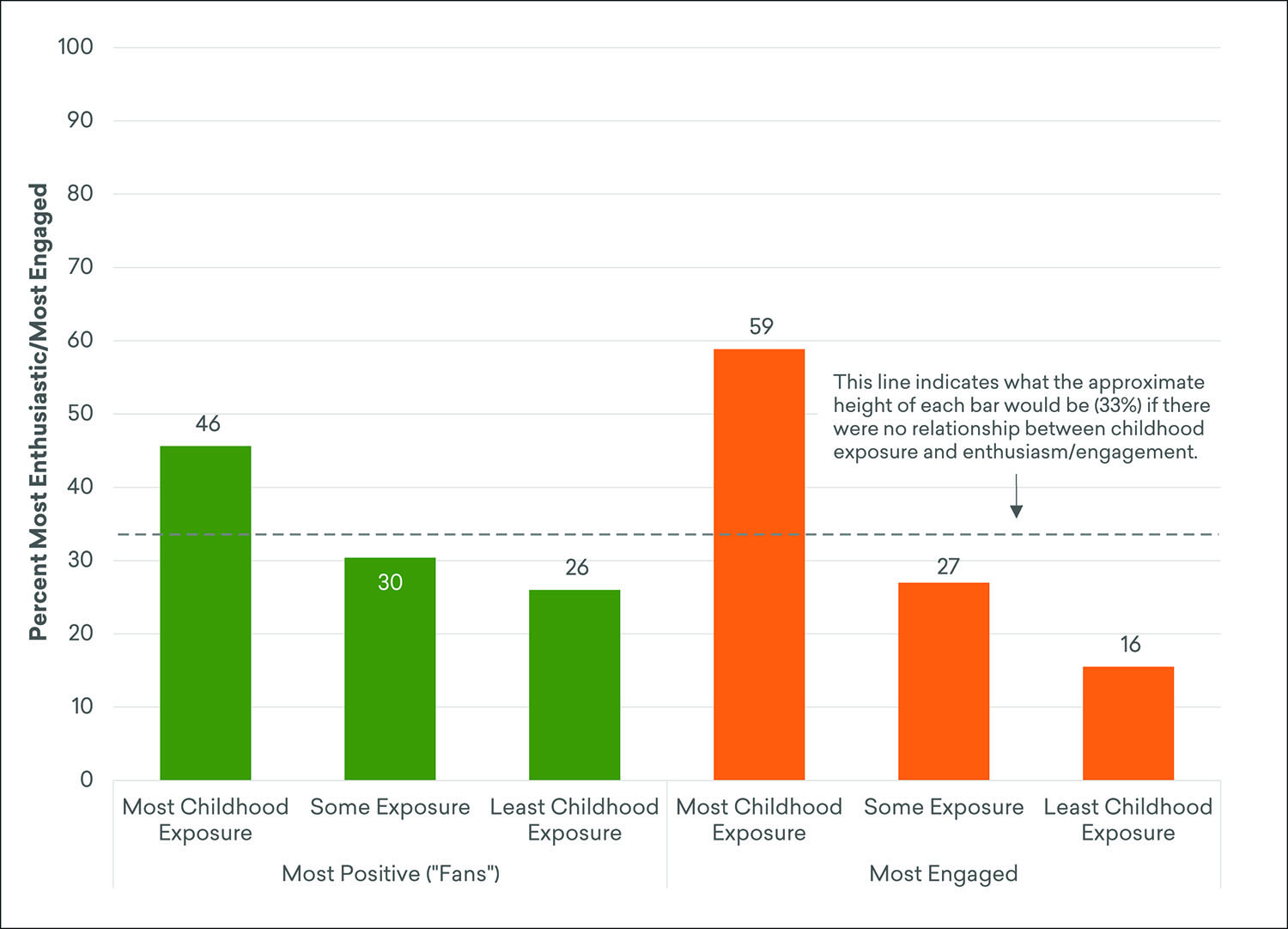
Source: Survey of the Humanities in American Life, 2019.
The relationship between childhood exposure and adult engagement was even stronger. Fifty-nine percent of the Americans who were highly exposed to the humanities as children were among the “most engaged” on the scale described in Chapter 1. Only 16% of the least exposed had a similar level of engagement with the humanities as adults.
Perceptions of the Importance of Humanities Education for Young People
As indicated in Chapter 2, over 90% of Americans agreed that the humanities should be an important part of every American’s education, and 87% believed that the humanities help children and adolescents develop the skills they need in life (see Figure 2B). Americans were also found to be at least as—if not more—favorably disposed to most of the field’s component disciplines as they were to the field as a whole. However, when it came to teaching humanities subjects to children, adults were less supportive of some disciplines than they were of humanities education broadly (Figure 3D).
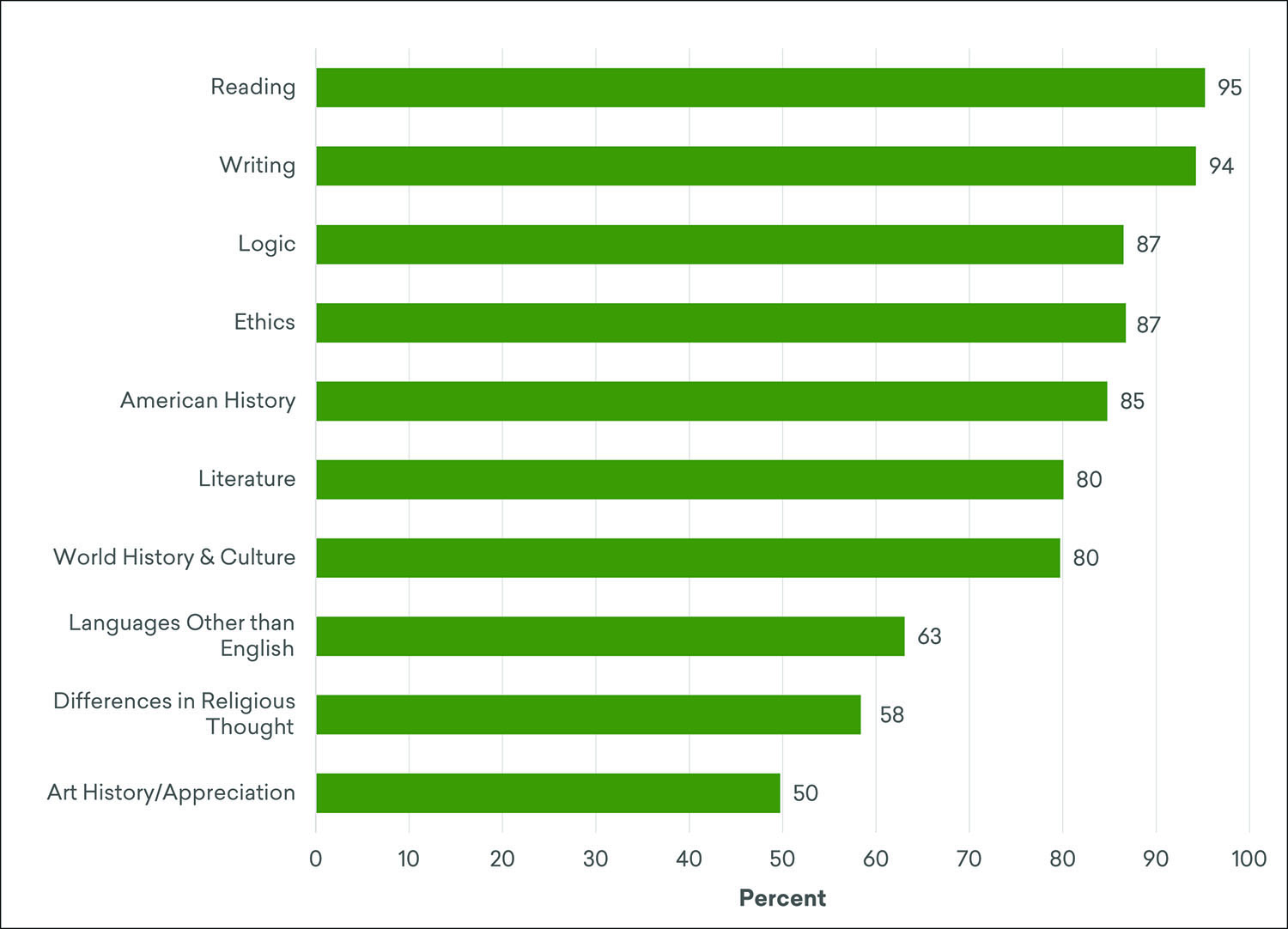
Source: Survey of the Humanities in American Life, 2019.
For most of the humanities subjects in the survey, including the basics of reading and writing, as well as ethics, logic, literature, and history (both of the United States and the world), at least 80% of Americans felt that teaching them to children was important or very important. But substantially smaller shares of Americans felt as positively about teaching young people languages other than English (LOTE),20 differences in religious thought, and art history/appreciation.
These results do not explain why a person might feel the teaching of a subject is unimportant. Someone could believe a particular subject is inherently unimportant, or they could have doubts about the nature or quality of the education a child would receive in that subject (even if they actually consider such knowledge essential). Once again, these findings beg further exploration into some of the underlying attitudes and beliefs.
LOTE, differences in religious thought, and art history/appreciation were also standouts in another respect, one in which they were joined by American history: the study found considerable variation among groups of Americans in their support for teaching this material (Figures 3E). For instance, except in the case of American history, women were substantially more likely than men to believe it important or very important that these subjects be taught to young people. In the case of art history/appreciation, for instance, more than half of women (55%) considered the subject at least important for a child’s education, compared to just 44% of men.
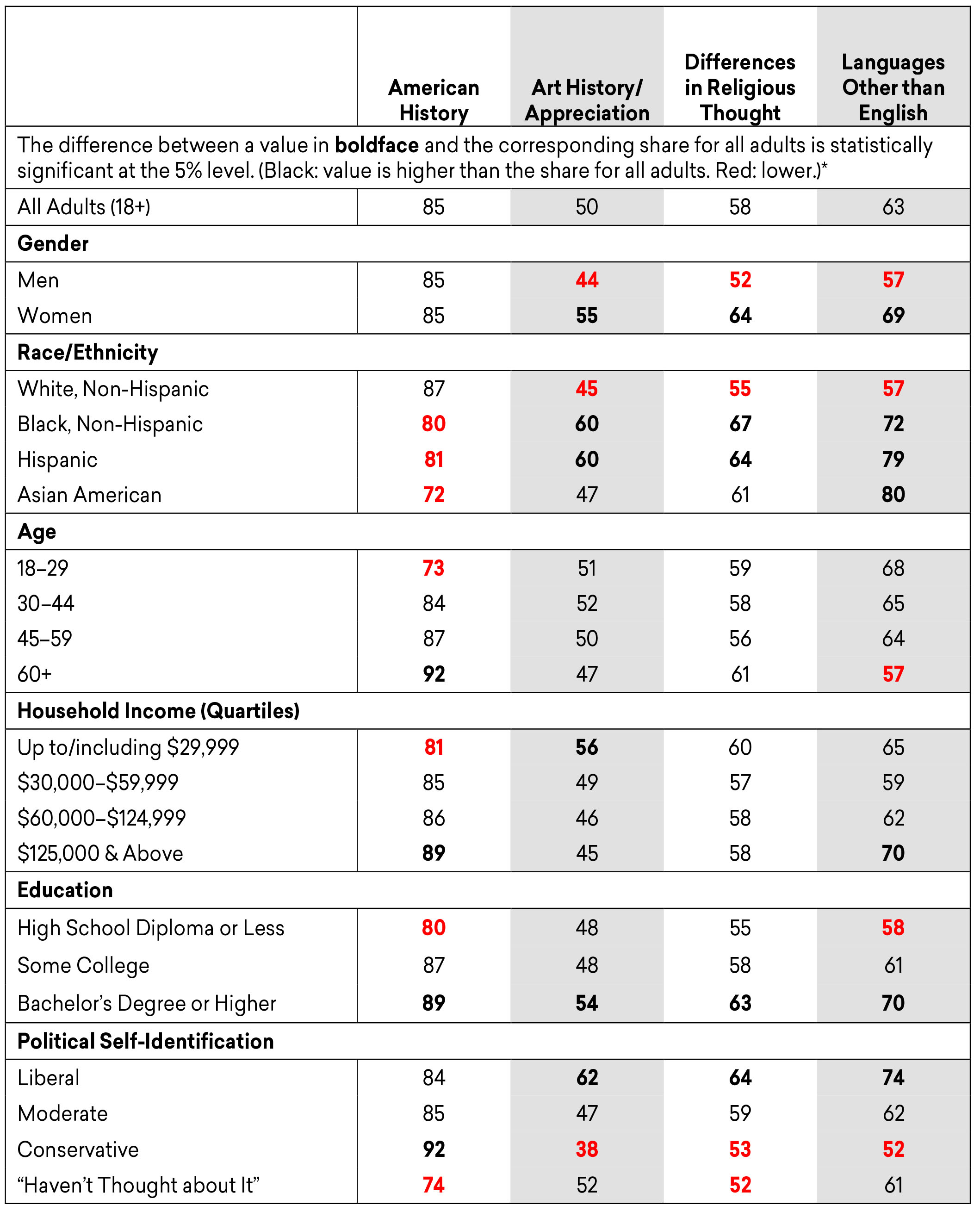
* Not every observed difference between demographic groups (e.g., between the youngest adults and those age 60+, or between Asian and White Americans) is statistically significant at the 5% level. The report narrative discusses notable differences that were found to be statistically significant.
Source: Survey of the Humanities in American Life, 2019.
Race was a salient dimension of variation for all four subjects. Black and Hispanic Americans were more likely than Whites to believe that teaching art history/appreciation and differences in religious thought was important. Blacks and Hispanics were joined by Asian Americans in being substantially more likely than White Americans to believe it important that young people learn LOTE. However, non-White Americans were less likely to see the teaching of American history to young people as important. The greatest gap was found between Asian and White Americans. Eighty-seven percent of White Americans believed teaching the country’s history to young people was important or very important, while 72% of Asian Americans expressed this view.
Political belief was also associated with Americans’ views of the importance of young people learning these subjects. Conservatives were markedly less likely than liberal Americans, and somewhat less likely than moderates, to consider art history/appreciation and LOTE important for young people to learn. Conservatives were also less likely to think that teaching primary and secondary students about differences in religious thought was important, but the disparity was not as pronounced. In contrast, conservative Americans were somewhat more likely than liberals and moderates to value the teaching of American history to youth.
Across virtually all the subjects included in the survey (including the additional topics shown in Figure 3F), apolitical Americans were much less likely than Americans with a political identification to believe that the teaching of humanities subjects was important or very important for youth. In the case of American history, world history, ethics, and logic, the share of apoliticals who felt that instruction was important for children was smaller than the share for each of the political segments. For every other subject except literature, apoliticals were less likely than liberals to feel it was important that children be taught the material. Only in the case of art were apoliticals more likely than members of one of the political groups (in this case, conservatives) to feel the teaching of a subject was more important.
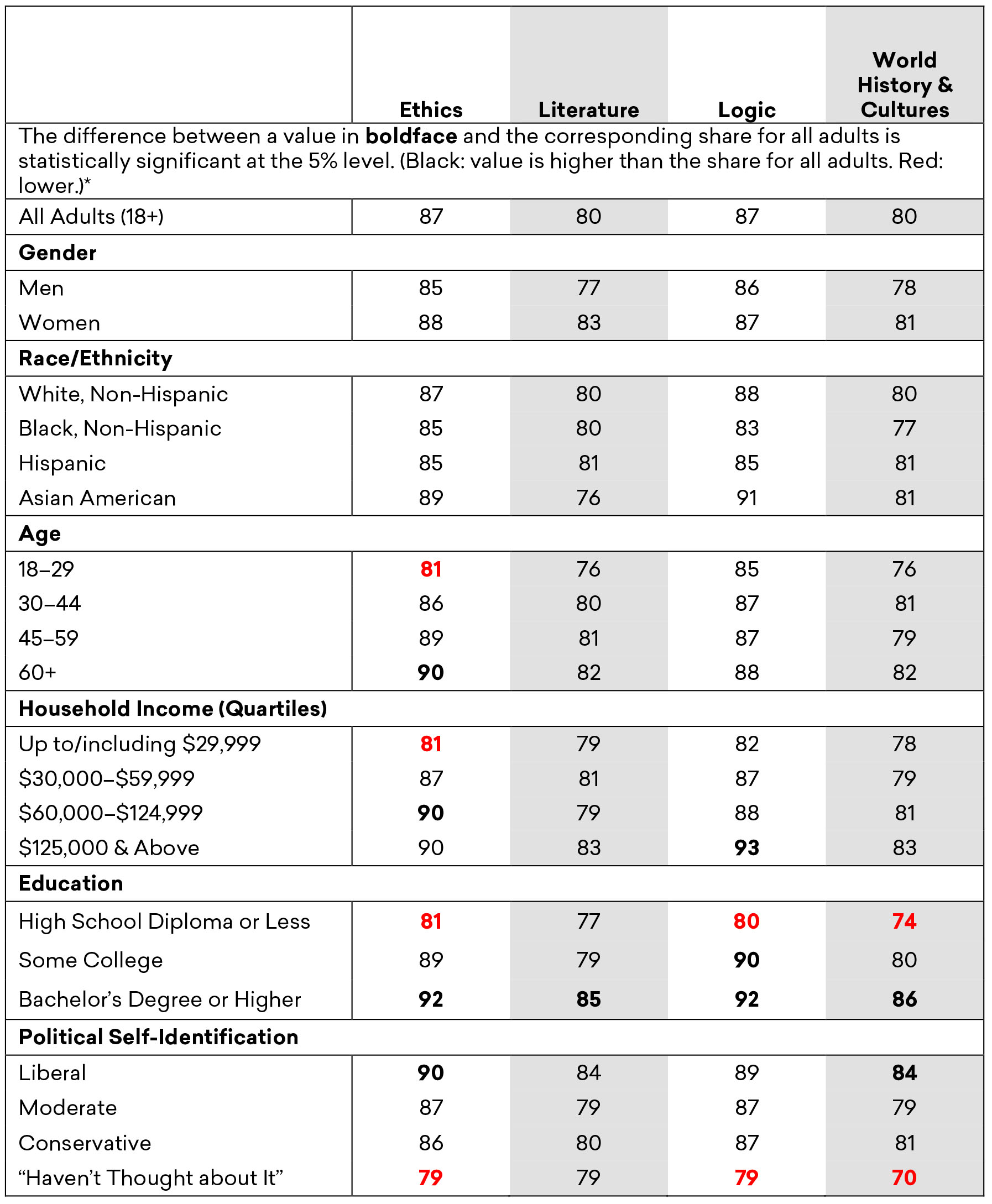
* Not every observed difference between demographic groups (e.g., between the youngest adults and those age 60+, or between Asian and White Americans) is statistically significant at the 5% level. The report narrative discusses notable differences that were found to be statistically significant.
Source: Survey of the Humanities in American Life, 2019.
As was the case for the attitudes toward the humanities in general (see Chapter 2), education level was consistently predictive of Americans’ attitudes about the value of teaching humanities subjects to children. Americans with college degrees were more likely than those with a high school diploma or less education to affirm the importance of teaching every humanities subject to young people. For example, while 86% of college graduates felt instruction in world history was important for young people, only 74% of Americans with a high school education or less shared this view. In the case of art, although the association was still positive, it was decidedly less pronounced than for most other subjects.
While large majorities of Americans supported teaching American history, ethics, literature, and world history to young people, older Americans were more likely than young adults to see their value. The gap between the two groups was particularly wide on the question of teaching American history. Whereas 73% of Americans ages 18 to 29 felt this sort of instruction was important or very important for young people to receive, the share of Americans age 60 and above who felt this way was 17 percentage points higher. LOTE was the only subject where the oldest adults were less likely than the youngest—and the middle-aged—to feel it important that children receive instruction.
Income and belief were correlated for all subjects except literature, world history, and differences in religious thought. In most cases, higher-income Americans were more likely to consider humanities education important, but for art history/appreciation the pattern was reversed. While 56% of Americans in the first income quartile felt this type of instruction was important for young people, only 45% of the most affluent Americans felt the same.
Where and When the Humanities Should Be Taught to Young People
For every humanities subject in the survey, a majority of Americans felt that instruction should occur both in a formal educational setting and outside it (in a student’s home, church, or community; Figure 3G). Approximately three-quarters of the adult population believed reading and ethics ought to be taught both within and beyond school walls—the largest shares among the subjects in the survey.
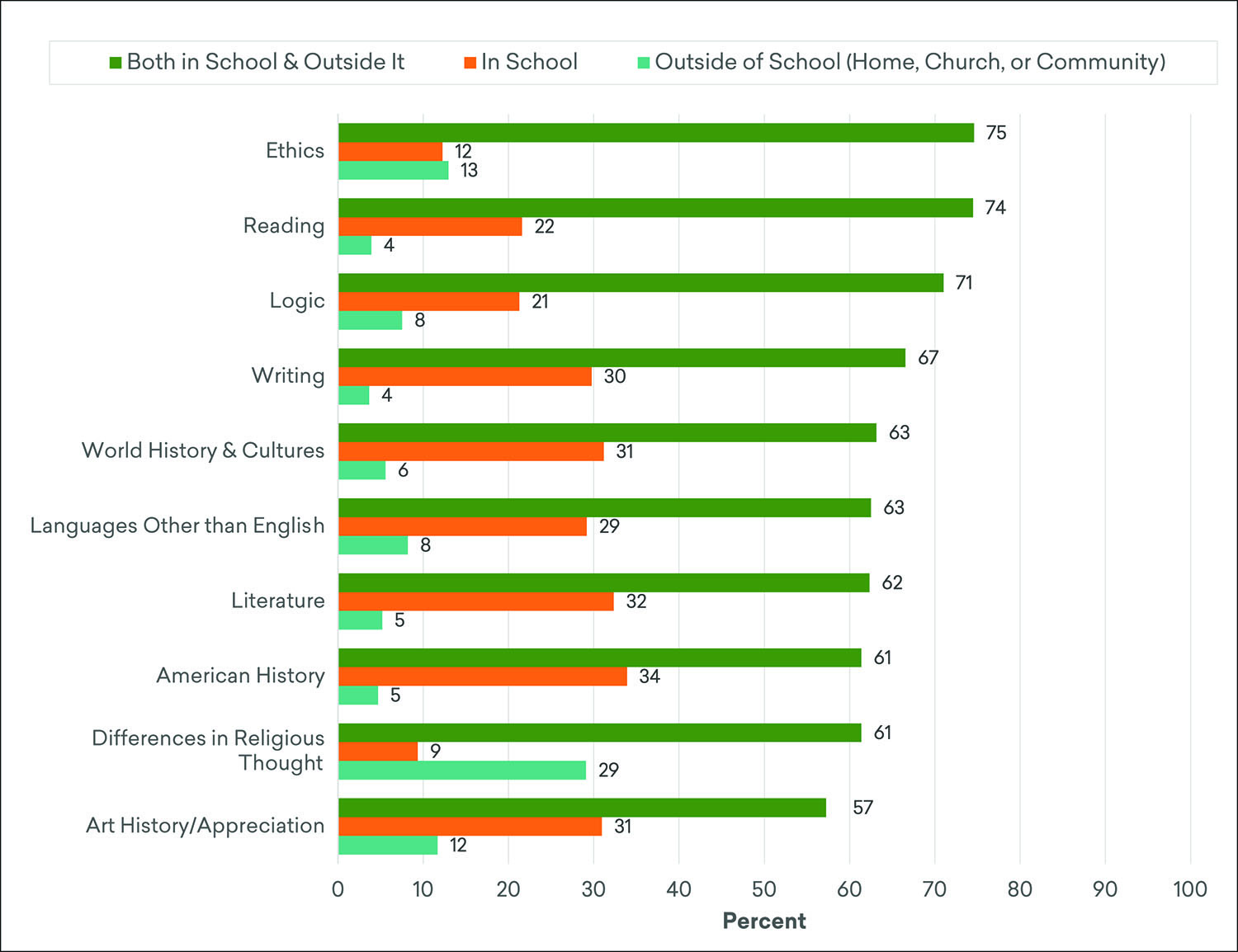
* The shares for a given subject may sum to 99% or 101% due to rounding.
Source: Survey of the Humanities in American Life, 2019.
For most subjects, less than 10% of adults felt that instruction should take place exclusively outside of school. Slightly larger shares felt that art history/appreciation (12%) and ethics (13%) were best taught outside of school, and a substantially larger share (29%) believed differences in religious thought should be taught this way.
As with Americans’ other opinions about humanities education and young people, this study does not tell us why Americans feel that a subject is best taught in a certain setting. For instance, someone might believe that a humanities subject (such as religion or ethics) is better taught outside of school due to a concern that school-based instruction will instill values at odds with those of a student’s family or community. Or the concern could be that schools will have less time to teach subjects considered more essential. One can also imagine multiple motivations for the belief that a subject should be taught only in school. Someone could feel that LOTE, for example, should be taught only in the schools because time with family and friends is better spent on other pursuits. Another person might value LOTE learning highly but not have the personal expertise or the monetary resources to obtain the professional help that would make learning outside school possible. Additional research will be necessary to understand what drives Americans’ attitudes about where children should study the humanities.
For every subject in the survey, Americans who felt a subject should be taught in school (including those who believe it should be taught both in school and in the home/church/community) were most likely to believe that instruction should begin at the elementary level. Beyond the basics of reading and writing, however, a substantial share felt that elementary school was too early for humanities learning (Figure 3H).21 Depending on the subject, between a third and 39% of Americans felt that the country’s history, LOTE, ethics, literature, and logic should be taught later in a student’s educational career. Substantially larger shares (52–60%) believed art history/appreciation, world history and cultures, and differences in religious thought should not be taught until middle school or later.
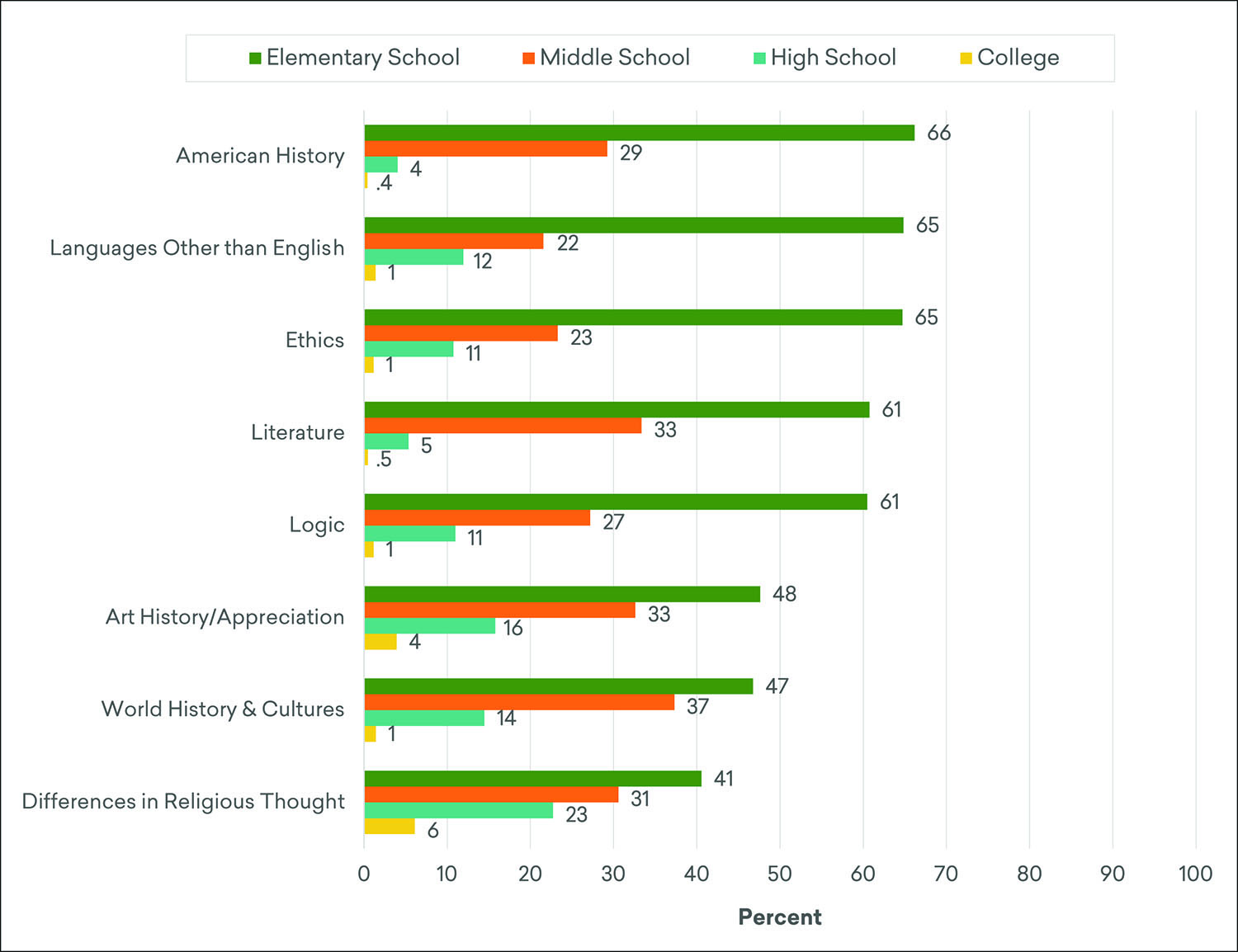
* Limited to people who indicated that they believed a subject should be taught at school or both at school and outside it (in home, church, or community). The shares for a given subject may sum to 99% or 101% due to rounding.
Source: Survey of the Humanities in American Life, 2019.
For all subjects, those who thought teaching should be delayed were most likely to want instruction postponed to middle school. The share of Americans who believed instruction should not begin until that time ranged from 22% for languages other than English to 37% for world history and cultures.22 For three subjects, however, nonnegligible shares of Americans believed that instruction should wait until high school. Approximately 15% of those who felt art history/appreciation and world history/culture should be taught in school believed that young people should not receive instruction of this kind until high school. An even larger share, 23%, believed the teaching of differences in religious thought should be similarly delayed.
Which Subjects Do Americans Wish They Had Studied More Of?
The study found that 78% of Americans wished they had taken more courses in at least one humanities subject in school, with languages other than English garnering the most interest (Figure 3I). Given a range of humanities and nonhumanities subjects to choose from (and allowed to select more than one), almost half of Americans (49%) chose LOTE, followed by computer science (45%), social and behavioral sciences (40%), and business (39%).
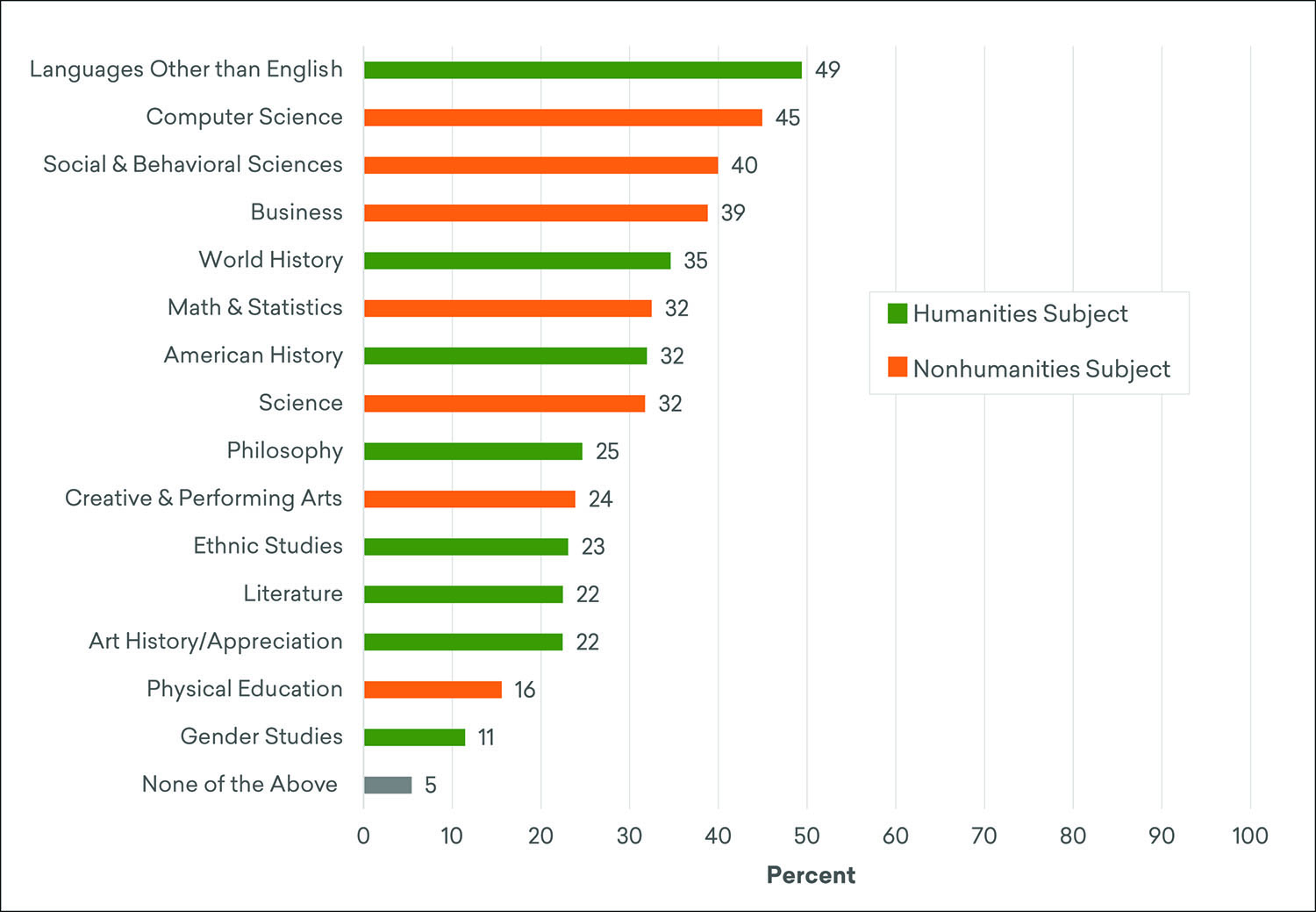
Source: Survey of the Humanities in American Life, 2019.
History was the second most popular among humanities subjects. Thirty-five percent of Americans wished they had studied more world history, and 32% felt they would have benefited from more American history. (Looking at history generally, 43% of Americans wished they had taken more courses in American and/or world history.) Philosophy, ethnic studies, literature, and art history/appreciation generated interest from 22% to 25% of Americans. (As a reminder, the survey was administered in fall 2019, well before the protests and national conversation around racial justice spurred by the death of George Floyd in police custody.) Just 11% of Americans wished they had taken more courses in gender studies.
It was not possible as part of this survey to explore the nature of the desire to have studied a given subject. It is not known for instance, whether expressed interest was for personal enrichment or professional advancement. It is also unclear how disinterest in a subject should be construed. A person might not wish to have studied more of a subject due to a negative experience (such as finding courses in the subject discouraging or not compelling). But another possibility is an awareness of opportunity costs: a person may have greatly enjoyed a given subject in school and taken a large number of classes in that area, but now realize that exposure to other subjects also would have been beneficial. Understanding what drives Americans’ preferences for humanities education will require further research.
The study does reveal, however, how different groups compare to one another and the adult population as a whole in their desire to have studied more humanities (Figures 3J & 3K). The discussion below treats each subject separately in order to provide profiles that can serve as decision-making resources for those designing humanities-focused education experiences both within and beyond school walls.
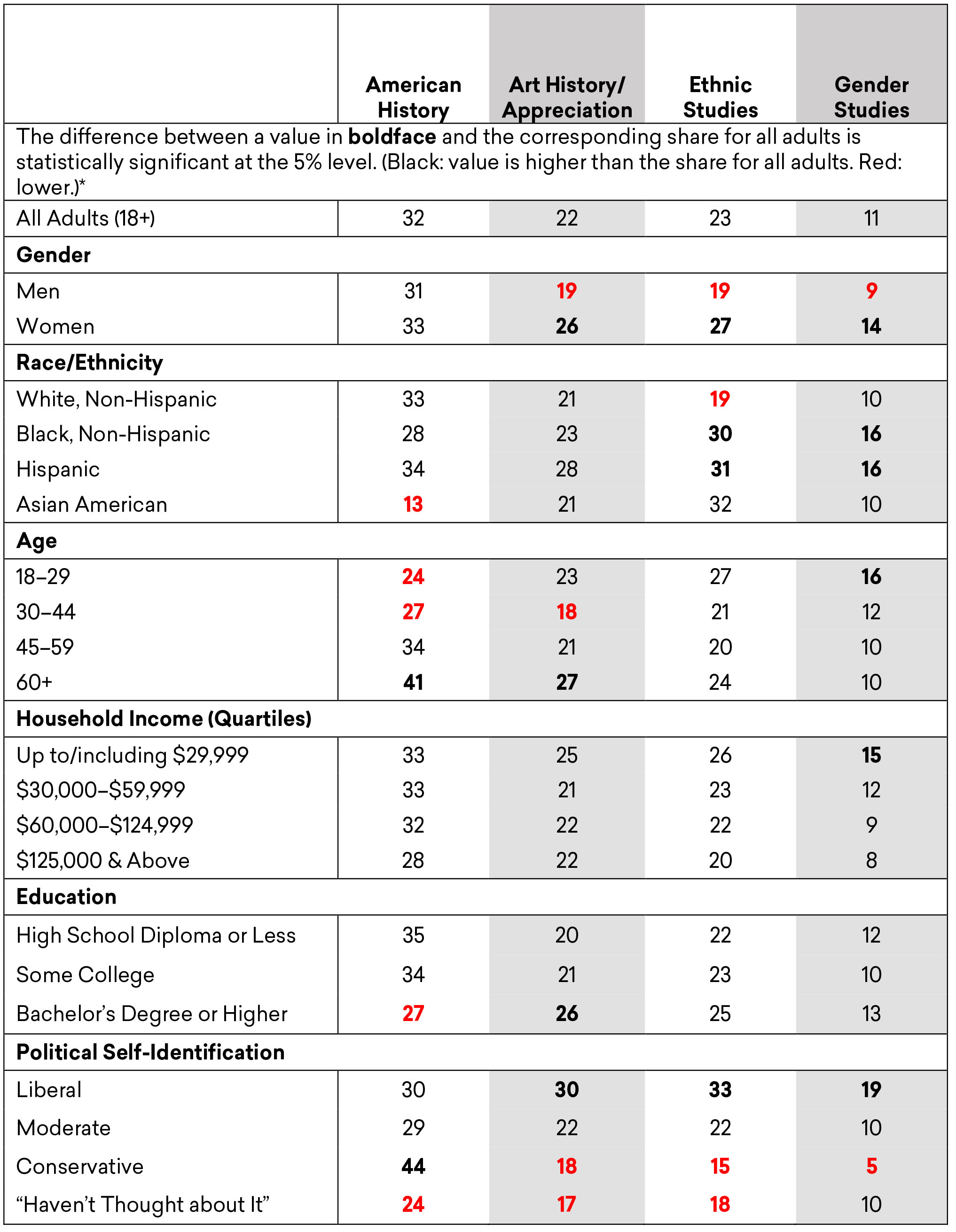
* Not every observed difference between demographic groups (e.g., between the youngest adults and those age 60+, or between Asian and White Americans) is statistically significant at the 5% level. The report narrative discusses notable differences that were found to be statistically significant.
Source: Survey of the Humanities in American Life, 2019.
American History
Americans with a bachelor’s degree were somewhat less likely than those with less education to wish they had taken more courses in the nation’s history. This was the only humanities subject for which this was true.
American history is also unique in that Americans identifying as conservative were considerably more likely to wish they had taken more classes in the subject than those with other political orientations or the apolitical. Forty-four percent of conservatives wished they had taken more courses in American history, but only about 30% of liberals and moderates, and less than one-quarter of apoliticals, felt the same. With the exception of world history, conservatives were less likely than liberals to wish they had studied more of every other subject.
Asian Americans were less likely than other racial/ethnic groups to wish they had studied American history (just 13%). Age was positively associated with the desire to have studied more history, with 41% of Americans age 60 and above indicating a desire for more American history study, as compared to less than one-quarter of Americans ages 18 to 29.
Art History and Appreciation
For art history/appreciation (and several other subjects), important variations were noted along gender lines, as 26% of women compared to just 19% of men wished they had taken more classes in the subject. Age also mattered. The oldest Americans (age 60 and above) were more likely than all but the youngest adults (ages 18 to 29) to wish they had studied more of the subject.
College graduates were somewhat more likely than less educated Americans to wish they had taken more art history/appreciation courses. Americans also differed along political lines: conservative Americans were substantially less likely than liberals to wish that art history/appreciation had been a bigger part of their education. Apolitical Americans were also found to be less likely than liberals to wish they had studied more of the subject.
Ethnic Studies
Women were more likely than men to wish they had taken more ethnic studies classes, and Whites were less likely than Asian, Black, and Hispanic Americans to feel this way. The least affluent Americans were somewhat more likely than the highest-income Americans to wish they had studied more of the subject.
Politically liberal Americans were more than twice as likely as conservatives—and substantially more likely than the apolitical and Americans generally—to wish they had taken more ethnic studies courses. This gap between liberals and conservatives was one of the largest (in percentage terms), second only to the disparity for gender studies.
Gender Studies
Although only a small share of women wished they had taken more gender studies classes, they were half again as likely as men to express such a desire. Black and Hispanic Americans were more likely than Whites to wish they had studied more of the subject, and the youngest adults were somewhat more likely than older generations.
Income was also a predictor of desire to have delved more deeply into this subject. The lowest-income Americans were almost twice as likely as the highest-income to wish they had taken more of the subject. Further investigation revealed that this disparity was not reducible to the fact that those of lower income were much more likely to be women than men. The difference was driven largely by male preferences. Men in the lowest income quartile were more than two-and-a-half times as likely as the most affluent men to wish they had taken more gender studies.
As with ethnic studies, a strong association was found between political identification and interest in gender studies, with almost one-fifth of Americans who described themselves as liberal expressing the wish to have taken more gender studies, compared to 5% of conservatives. This was the largest gulf found (in percentage terms) between these two political segments for any of the subjects. Liberals were also more likely than moderates and apolitical Americans to wish that gender studies had been a greater part of their education.
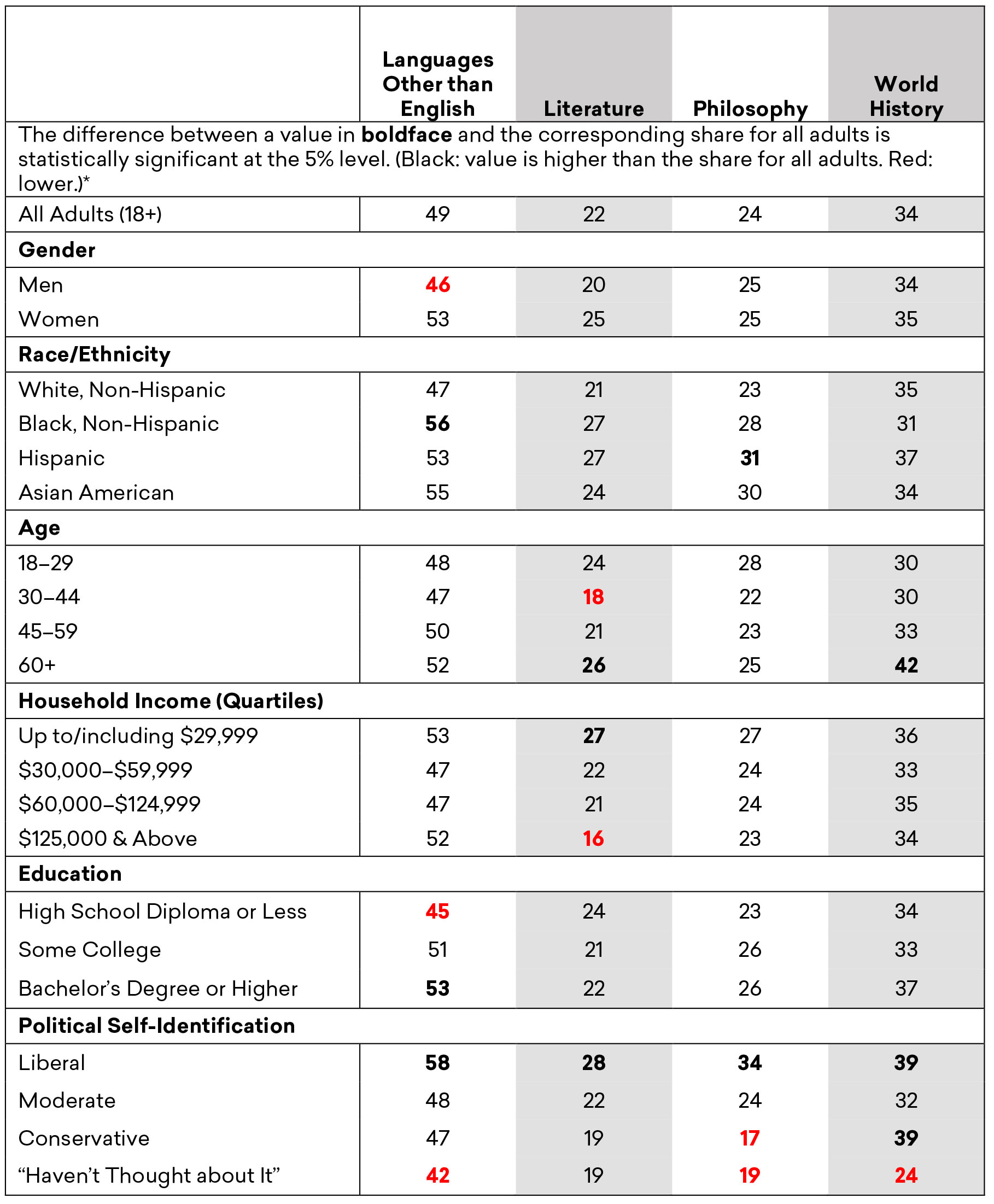
* Not every observed difference between demographic groups (e.g., between the youngest adults and those age 60+, or between Asian and White Americans) is statistically significant at the 5% level. The report narrative discusses notable differences that were found to be statistically significant.
Source: Survey of the Humanities in American Life, 2019.
Languages Other than English
As was true for several other subjects, women were more likely than men to wish they had more exposure to LOTE as students. Black and Hispanic Americans were found to be more likely than Whites to wish they had taken more classes in the subject. Along with race and gender, education was also predictive of whether Americans wished they had studied more LOTE. College-educated Americans were somewhat more likely than those with a high school diploma or less education to express a desire to have taken more of the subject. Finally, liberals were more likely than moderates, conservatives, and apolitical Americans to wish they had engaged in more LOTE study.
Literature
Literature was like LOTE in that women were more likely than men, and Black and Hispanic Americans more likely than Whites, to indicate that they wished they had studied more of the subject—though the disparities were less pronounced than with LOTE. And while age was positively associated with the desire to have studied more literature, the age bracket most different from the oldest Americans in this respect was not the youngest but the 30-to-44-year-olds.
In contrast to age, income was negatively associated with literature study. While over one-quarter of Americans in the lowest income quartile expressed a desire to have studied more in this area, only 16% of the highest-income Americans did.
Differences along political lines were also noted, with Americans who identify as liberal being more likely than moderates, conservatives, and the apolitical to wish they had studied more literature.
Philosophy
Women were no more likely to wish they had studied philosophy than men, but Black Americans and Hispanics were found to be somewhat more likely than Whites to wish they had taken more classes in the subject. The wish to have taken more philosophy courses was also strongly associated with political belief. Americans identifying as liberal were twice as likely as conservatives and considerably more likely than apolitical Americans to wish they had studied the subject more.
World History
World history was similar to philosophy in that the study found fewer between-group differences for this subject than for others. A correlation emerged, however, between age and a desire to have studied more world history, driven by the comparatively large share of the oldest Americans who wished they had received more education in the subject. While approximately one-third of younger Americans expressed a desire to have studied more world history, 42% of Americans age 60 or above held this opinion.
Unlike the other subjects, Americans toward the poles of the political spectrum were more likely than moderates or the apolitical to wish they had learned more about world history. While 39% of both liberals and conservatives wished they had taken more classes in the subject, less than one-third of moderates and only 24% of apoliticals shared that sentiment.
Humanities Subjects and College Majors
A key question the study sought to answer was how likely STEM majors were to wish they had studied more humanities subjects as part of their formal education. Analysis turned up few differences between STEM majors and college graduates in general. All the observed differences between Americans who had majored in a STEM field—whether engineering/computer sciences, health and medical science, or the natural sciences—and college graduates in general were eight percentage points or less, and in only two instances was the difference found to be statistically significant. College graduates who had majored in health and medical sciences as undergraduates were somewhat less likely than college graduates generally to wish they had taken more American history in college, with only 19% of such majors expressing this desire, as compared to 27% of all bachelor’s degree–holders. For art history and appreciation, 18% of engineering and computer science majors wished they had taken more of such courses, compared to 26% of all college graduates.
As for the wish to study the humanities more generally, no notable differences were found among the majors. For every major—including humanities majors—the average graduate wished they had taken more courses in two to three (out of eight) subjects in the survey.
____________________
The next chapter examines the role that skills acquired via humanities education—such as reading, writing, historical perspective, and cross-cultural understanding—played in Americans’ work lives. The first set of findings deals with the extent to which people deployed these skills on the job. The remainder of the chapter explores whether Americans felt they lacked the humanities-related competencies necessary to succeed at work.